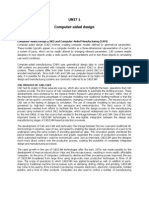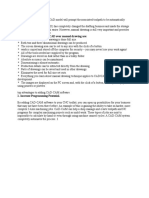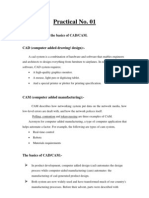0 ratings0% found this document useful (0 votes)
9 viewsWa0058 PDF
Wa0058 PDF
Uploaded by
koustav4workA ppt on the topic of future trends in CAD/ CAM
Copyright:
© All Rights Reserved
Available Formats
Download as PDF, TXT or read online from Scribd
Wa0058 PDF
Wa0058 PDF
Uploaded by
koustav4work0 ratings0% found this document useful (0 votes)
9 views15 pagesA ppt on the topic of future trends in CAD/ CAM
Original Title
DOC-20240805-WA0058.pdf
Copyright
© © All Rights Reserved
Available Formats
PDF, TXT or read online from Scribd
Share this document
Did you find this document useful?
Is this content inappropriate?
A ppt on the topic of future trends in CAD/ CAM
Copyright:
© All Rights Reserved
Available Formats
Download as PDF, TXT or read online from Scribd
Download as pdf or txt
0 ratings0% found this document useful (0 votes)
9 views15 pagesWa0058 PDF
Wa0058 PDF
Uploaded by
koustav4workA ppt on the topic of future trends in CAD/ CAM
Copyright:
© All Rights Reserved
Available Formats
Download as PDF, TXT or read online from Scribd
Download as pdf or txt
You are on page 1of 15
ACADEMY OF TECHNOLOGY
DEPARTMENT – MECHANICAL SEMESTER – 7TH
PAPER NAME- CAD/CAM. SUBJECT CODE- PE-ME702J
POWER POINT PRESENTATION ON
“Discuss the application and future trends of CAD/CAM”
PRESENTED BY
NAME- KOUSTAV MUKHERJEE. UNIVERSITY ROLL NO – 16900721012
To fulfil the requirement of Continuous Assessment 1 [CA1] of B. Tech Course.
INTRODUCTION
• CAD (Computer-Aided Design) and
CAM (Computer-Aided
Manufacturing) are technologies that
streamline the design and production
process. CAD enables the creation of
detailed digital models, while CAM
translates these designs into machine
instructions for precise
manufacturing, enhancing efficiency,
accuracy, and innovation across
various industries.
DEFINATION
APPLICATIONS
• Design and Prototyping: CAD (Computer-
Aided Design) allows engineers and
designers to create detailed 2D or 3D
models of products. These models can be
analyzed, modified, and optimized before
any physical prototype is made, saving
time and resources. CAM (Computer-Aided
Manufacturing) takes these designs and
converts them into machine-readable
instructions for manufacturing processes
like CNC machining, 3D printing, or laser
cutting.
MANUFACTURING
• CAM systems automate
the manufacturing
process by using the
CAD model to generate
the tool paths and
machine operations.
This ensures precision,
reduces errors, and
increases production
efficiency
PRODUCT LIFE MANAGEMENT (PLM)
• CAD/CAM systems
integrate with PLM software
to manage a product’s
lifecycle from inception
through engineering design
and manufacturing to
service and disposal. This
ensures consistency and
traceability throughout the
product’s life
CUSTOMISATION & RVERSE ENGINEERING
FUTURE TRENDS
• Generative Design: CAD tools will increasingly feature
generative design, where the software autonomously
creates a range of design solutions based on input
constraints and goals. This allows for more innovative
designs and rapid iteration.
• Enhanced Simulation and Virtual Reality (VR): Future
CAD/CAM systems may offer more advanced simulation
tools that allow designers to test and validate their
designs in a virtual environment. VR and AR (Augmented
Reality) technologies could further enhance the design
and review process, making it more immersive and
intuitive.
ADDITIVE MANUFACTURING
• Additive Manufacturing:
The integration of
CAD/CAM with additive
manufacturing (3D
printing) is evolving. As 3D
printing technology
advances, CAD/CAM will
need to adapt to new
materials, complex
geometries, and multi-
material printing.
• Sustainability: As industries move towards more
sustainable practices, CAD/CAM software will
incorporate tools to help reduce material waste,
optimize energy use in manufacturing processes, and
design products that are easier to recycle or reuse
• Interoperability and Standards: There will be an
increased emphasis on the interoperability of
CAD/CAM systems, allowing for seamless data
exchange between different platforms and reducing
compatibility issues.
ADVANTAGES & DISADVANTAGES
CONCLUSION
• CAD/CAM technologies revolutionize the
design and manufacturing landscape by
enabling precision, reducing time-to-
market, and fostering innovation. As
these tools evolve with AI, cloud
computing, and advanced simulations,
they will further enhance product
development processes, making
manufacturing more efficient,
customizable, and sustainable. Their
impact on industries is profound and
continually expanding.
REFFERENCES
• CAD/CAM: Theory and Practice” by
Ibrahim Zeid and
R.Sivasubramanian.
• “Principles and Applications” by M.J.
Srinivas.
• “CAD/CAM: Concepts and
Applications” by Chennakesava R.
Alavala .
THANK YOU
You might also like
- Low Level Flash Cooler System - PresentationDocument18 pagesLow Level Flash Cooler System - PresentationpavijayaNo ratings yet
- Universiti Kuala Lumpur Malaysian Institute of Marine Engineering Technology (Unikl Mimet)Document14 pagesUniversiti Kuala Lumpur Malaysian Institute of Marine Engineering Technology (Unikl Mimet)Haiqal MarizanNo ratings yet
- Study of Computer Aided Design and Mechanical Design by Computer SoftwareDocument6 pagesStudy of Computer Aided Design and Mechanical Design by Computer SoftwareAmba Lrcfools InfosNo ratings yet
- The Role of Computer Aided Design (CAD) in The Manufacturing and Digital Control (CAM)Document16 pagesThe Role of Computer Aided Design (CAD) in The Manufacturing and Digital Control (CAM)Paddy Nji KilyNo ratings yet
- Importance of Cad&camDocument7 pagesImportance of Cad&camRitu MaityNo ratings yet
- DO Seminar ReportDocument18 pagesDO Seminar ReportMithun N Gowda ME-MD-2019-21No ratings yet
- A ReportDocument8 pagesA ReportTyNo ratings yet
- Reserch Paper 12Document15 pagesReserch Paper 12Hafiz MuhammadNo ratings yet
- Computer Aided Design and Manufacturing (Final Submission)Document37 pagesComputer Aided Design and Manufacturing (Final Submission)Momoh OsazeleNo ratings yet
- MEC435 Chapter1Document49 pagesMEC435 Chapter1najmi_najmi_muhammad96No ratings yet
- Computer Aided Drafting Week 1Document7 pagesComputer Aided Drafting Week 1mosesbala078No ratings yet
- Prodcut CCDocument11 pagesProdcut CCKrishna KumarNo ratings yet
- CAD/CAM Means Computer-Aided Design and Computer-Aided Manufacturing. It Is The TechnologyDocument10 pagesCAD/CAM Means Computer-Aided Design and Computer-Aided Manufacturing. It Is The TechnologyRavi SekharNo ratings yet
- Cad Cam CaeDocument25 pagesCad Cam Caesadananda_pvc100% (1)
- SHASHANK REPORT-1 - MergedDocument28 pagesSHASHANK REPORT-1 - MergedPunithNo ratings yet
- Gangam Style 24Document20 pagesGangam Style 24Light WorkerNo ratings yet
- Evolution of CAD/CAM: Mit, UsaDocument63 pagesEvolution of CAD/CAM: Mit, UsaNaveenNo ratings yet
- Assignment 1 CadcamDocument3 pagesAssignment 1 CadcamLuqman HakimNo ratings yet
- mgtCADCAM TAMAYODocument3 pagesmgtCADCAM TAMAYONath ReyesNo ratings yet
- Catia V5: Role in The IndustryDocument30 pagesCatia V5: Role in The Industrycadd puthurNo ratings yet
- Lab Cadcam Iqbal KinaDocument8 pagesLab Cadcam Iqbal KinaAnonymous OX8ioagTCNo ratings yet
- Basic Manufacturing Process Assignment (Me204) : Cad, Cam and CimDocument20 pagesBasic Manufacturing Process Assignment (Me204) : Cad, Cam and CimRaghunath VeeramaniNo ratings yet
- Cse Cad Cam ReportDocument18 pagesCse Cad Cam Reportaur08nt557No ratings yet
- Gangam Style 6Document31 pagesGangam Style 6Light WorkerNo ratings yet
- InternshipDocument33 pagesInternshipsravankumarNo ratings yet
- Introduction To Cad/Cam: Arvind DeshpandeDocument38 pagesIntroduction To Cad/Cam: Arvind DeshpandeKarthi KeyanNo ratings yet
- The Future of CAD CAMDocument8 pagesThe Future of CAD CAMThanos100% (10)
- CAD-CAM PresentationDocument14 pagesCAD-CAM PresentationScribdTranslationsNo ratings yet
- Cad Cam NotesDocument21 pagesCad Cam NotesarivaazhiNo ratings yet
- Cad CamDocument21 pagesCad CamGGR100% (1)
- Present and Future Impacts of Computer ADocument9 pagesPresent and Future Impacts of Computer ANejra AlibasicNo ratings yet
- Introduction To CADDocument3 pagesIntroduction To CADMaaruf Khan PathanNo ratings yet
- CAD CAM NoteDocument9 pagesCAD CAM Noteq5bdcs4ftfNo ratings yet
- Reverse Engineering: A New Trend in ManufacturingDocument13 pagesReverse Engineering: A New Trend in ManufacturingNalliah PrabakaranNo ratings yet
- TeresDocument1 pageTeresvibush VarshanNo ratings yet
- CADCAM MinDocument91 pagesCADCAM MinBandi KumarreddyNo ratings yet
- CAD CAM (5TH Semester)Document23 pagesCAD CAM (5TH Semester)Foysal AhamedNo ratings yet
- F4004a04 Phy Term Paper.Document14 pagesF4004a04 Phy Term Paper.lksingh1987No ratings yet
- TPP Cad Cam TechnologyDocument19 pagesTPP Cad Cam TechnologyTanmay Kshirsagar TKNo ratings yet
- MEC435 Chapter1 v1.1 PDFDocument47 pagesMEC435 Chapter1 v1.1 PDFSyed AzzizNo ratings yet
- Cad-Cam Manual PDFDocument34 pagesCad-Cam Manual PDFM.Saravana Kumar..M.E100% (3)
- Unit-1 - CAD - V02Document21 pagesUnit-1 - CAD - V02muthupuviNo ratings yet
- Some of The Advantages of CAD Over Manual Drawing AreDocument8 pagesSome of The Advantages of CAD Over Manual Drawing AreNanda KishoreNo ratings yet
- Report Cad Cam.Document12 pagesReport Cad Cam.Wan Azlizan Zakaria33% (3)
- Me704 Cim (Cad)Document25 pagesMe704 Cim (Cad)ASHU KNo ratings yet
- Introduction To CAMDocument42 pagesIntroduction To CAMapoorva.choudhary02No ratings yet
- Some of The Advantages of CAD Over Manual Drawing AreDocument16 pagesSome of The Advantages of CAD Over Manual Drawing AreLight WorkerNo ratings yet
- Introduction To Cad/Cam: Arvind DeshpandeDocument38 pagesIntroduction To Cad/Cam: Arvind Deshpandearvan04No ratings yet
- The Significance and Evolution of ComputerDocument5 pagesThe Significance and Evolution of ComputerRuwan PareraNo ratings yet
- Sub-Module 1.1 - Introduction of Computer GraphicsDocument18 pagesSub-Module 1.1 - Introduction of Computer GraphicsNeeraj GuptaNo ratings yet
- Term Paper of Mechanical SciencesDocument12 pagesTerm Paper of Mechanical SciencesamitmaheshpurNo ratings yet
- ON Product Design and Manufacturing: Prepared byDocument25 pagesON Product Design and Manufacturing: Prepared byChinmay BeheraNo ratings yet
- Cad CFD Lab Manual PDFDocument77 pagesCad CFD Lab Manual PDFsumanthNo ratings yet
- Computer-Aided Design (CAD), Also Known As Computer-Aided Design and Drafting (CADD)Document15 pagesComputer-Aided Design (CAD), Also Known As Computer-Aided Design and Drafting (CADD)mech118No ratings yet
- 01 SSCHANI CV CAx PLMDocument7 pages01 SSCHANI CV CAx PLMEr Chinmoy NandaNo ratings yet
- 3D Cad - An Emergent Tool For Concept DesignDocument4 pages3D Cad - An Emergent Tool For Concept DesignAdvanced Research PublicationsNo ratings yet
- Practical No. 01: Objective: - Study The Basics of CAD/CAMDocument4 pagesPractical No. 01: Objective: - Study The Basics of CAD/CAMapi-26046805No ratings yet
- A Presentation On: Unit VI: CAD Customization & Automation By, ByDocument41 pagesA Presentation On: Unit VI: CAD Customization & Automation By, Byvishwajeet patilNo ratings yet
- Geometric Modeling: Exploring Geometric Modeling in Computer VisionFrom EverandGeometric Modeling: Exploring Geometric Modeling in Computer VisionNo ratings yet
- CNC Machine Mastery: From Fundamentals to Technical and CNC Job Interview Q&AFrom EverandCNC Machine Mastery: From Fundamentals to Technical and CNC Job Interview Q&ANo ratings yet
- Inside Shopify's Modular Monolith - by DR Milan MilanovićDocument12 pagesInside Shopify's Modular Monolith - by DR Milan Milanovićgk_sezhianNo ratings yet
- Episode 4 Assessing Learning in Different LevelsDocument4 pagesEpisode 4 Assessing Learning in Different LevelsBlessildajoy CruzNo ratings yet
- Digital Marketing Checklist: Housekeeping and PrepDocument6 pagesDigital Marketing Checklist: Housekeeping and PrepWondemagenAli100% (2)
- Fill in The Blanks (ObliconDocument25 pagesFill in The Blanks (ObliconJessamineRasulNo ratings yet
- Digital Gyro STD 22 PDFDocument4 pagesDigital Gyro STD 22 PDFViliame D RoqicaNo ratings yet
- CIS Promotions FY19Document42 pagesCIS Promotions FY19manu.whatsup1986No ratings yet
- Subject CombinationDocument5 pagesSubject Combinationchintupanda2000No ratings yet
- Philhealth Employees DataDocument44 pagesPhilhealth Employees DataJoshua LoyolaNo ratings yet
- New Oci Card Us MinorDocument6 pagesNew Oci Card Us Minorrajanikant_singhNo ratings yet
- SolidCAM 2014 EngDocument39 pagesSolidCAM 2014 EngĆosić AsimNo ratings yet
- Mkyza Trading Company ProfileDocument11 pagesMkyza Trading Company ProfileJessica CastroNo ratings yet
- Prev Up Next: Motorcycle FutureDocument4 pagesPrev Up Next: Motorcycle Futurerenate_ellaNo ratings yet
- SeaweedDocument3 pagesSeaweednat_wmsu2010No ratings yet
- Study Plan For PHDDocument2 pagesStudy Plan For PHDRehab sayed67% (3)
- 16 Chrysler Philippines Labor Union (CPLU) vs. Hon. Estrella G.R. No. L-46509Document2 pages16 Chrysler Philippines Labor Union (CPLU) vs. Hon. Estrella G.R. No. L-46509Monica FerilNo ratings yet
- Details About Nucleonic Gauge Training Course - DyDocument4 pagesDetails About Nucleonic Gauge Training Course - DyDeepak YadavNo ratings yet
- Organic Products and Their Recommended UsesDocument25 pagesOrganic Products and Their Recommended UsesSeok Heon KimNo ratings yet
- Di650i t3 Specification Sheet EnglishDocument4 pagesDi650i t3 Specification Sheet EnglishDaniel JanusauskasNo ratings yet
- 4.5 Uniform Customs & Practice For Documentary CREDITS (UCP 600) & eUCP v.1Document103 pages4.5 Uniform Customs & Practice For Documentary CREDITS (UCP 600) & eUCP v.1AprilNo ratings yet
- M.Pharm. (Medicinal Chemistry) - 2015-16Document47 pagesM.Pharm. (Medicinal Chemistry) - 2015-16Tripti PadaliaNo ratings yet
- GGBSDocument20 pagesGGBSratnakarNo ratings yet
- Types of CablesDocument19 pagesTypes of CablesJimmy Makiling PamugasNo ratings yet
- YearbookDocument71 pagesYearbookGoran PetrovicNo ratings yet
- Method of Shearing Test For Fillet Weld Joint: Nissan Engineering StandardDocument5 pagesMethod of Shearing Test For Fillet Weld Joint: Nissan Engineering StandardRicardo F.A.No ratings yet
- Mental Health Services Data Set (MHSDS) Autism Statistics: Metadata FileDocument4 pagesMental Health Services Data Set (MHSDS) Autism Statistics: Metadata FileLauren-Jodie WilsonNo ratings yet
- Kinds of JointsDocument9 pagesKinds of Jointsjojo bernabeNo ratings yet
- Directive 2007/46 ECDocument160 pagesDirective 2007/46 ECAmerican Import Agents AssociationNo ratings yet
- Proposal Document On Design and Development of Game Application Similar To METAL SLUGDocument17 pagesProposal Document On Design and Development of Game Application Similar To METAL SLUGJefferson R. OuvidorNo ratings yet
- Hubungan Pengetahuan Perawat, Kemampuan Kebijakan Rs. Fase Respon Bencana Igd Rs - Yarsi BukittinggiDocument8 pagesHubungan Pengetahuan Perawat, Kemampuan Kebijakan Rs. Fase Respon Bencana Igd Rs - Yarsi BukittinggiJoko MardiyonoNo ratings yet

























































































